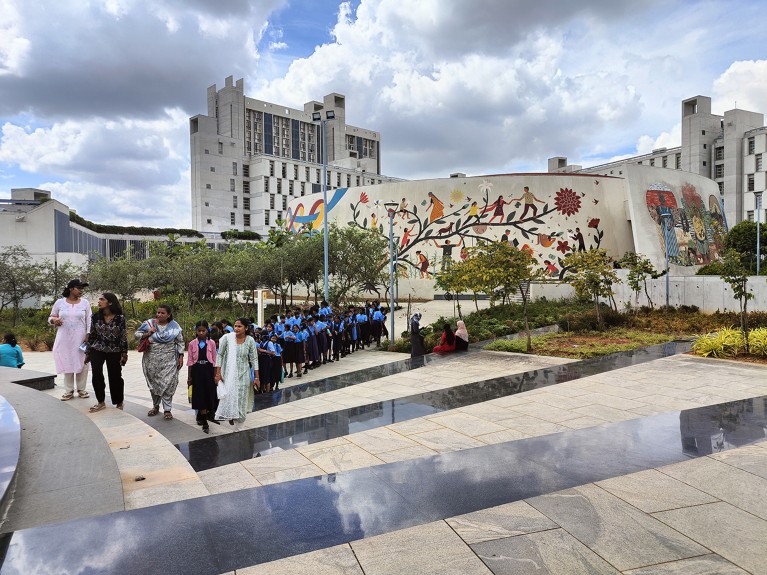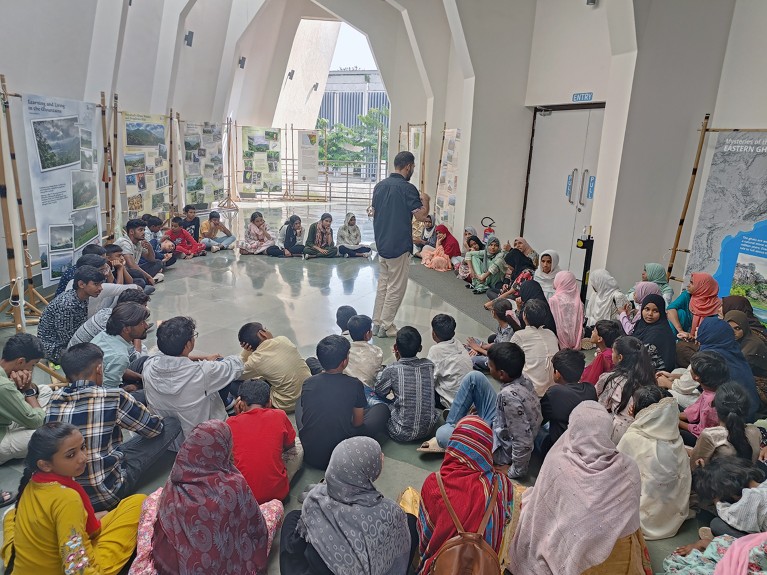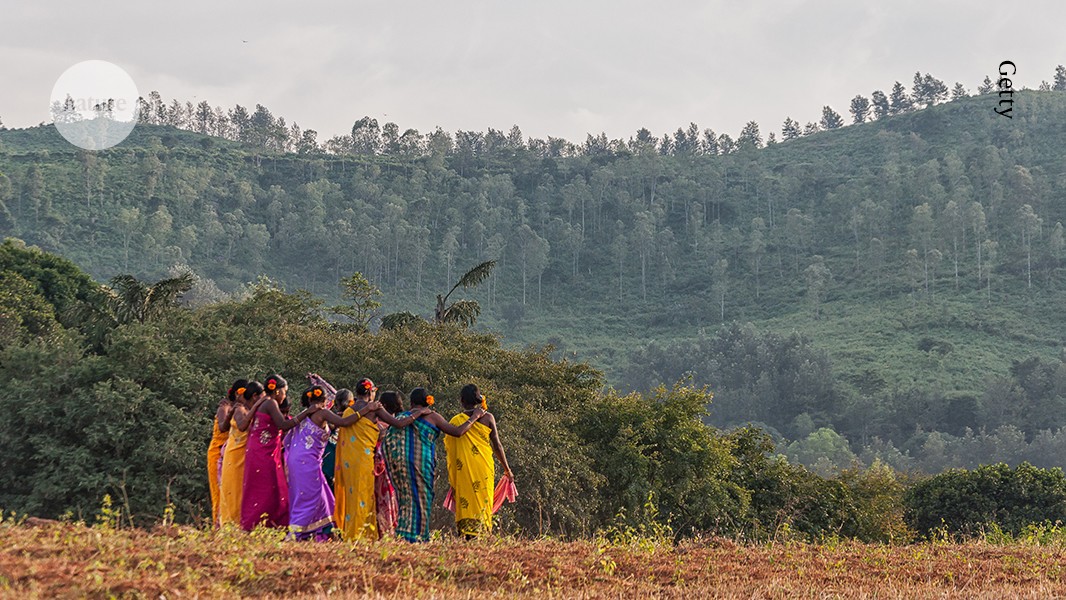Science is necessary, but clearly not sufficient, for conveying the climate crisis. The past two years have been the hottest on record. Denial of climate change is still widespread and false claims about products’ environmental benefits, or ‘greenwashing’, are on the rise. What can researchers do?
A decade ago, many scientists tended to argue that the best way they could contribute to the climate debate was to publish good ‘policy-relevant’ research — and then leave it to governments and civil-society actors to translate this science into action. The United Nations Intergovernmental Panel on Climate Change (IPCC) has done tremendous work in collating evidence that demonstrates the dangers of global warming and charting pathways to action. Yet, total annual global greenhouse-gas emissions are projected to be more than 60% higher in 2025 than they were in 1990, when the first IPCC report was published.
Climate scientists study a world in which change is the only constant, where the collapse of our planet’s systems is widespread and evident. Most of these researchers battle a deep sense of sadness, coupled with anxiety about the future and the young people they love and care for, who will inherit a damaged planet. We must continue to document change, model impacts and describe solutions — but we cannot stop there.
Young people are crucial to research — how can they be paid fairly?
Increasingly, many climate scientists are embracing climate activism. I am a huge admirer of those who do, and have engaged in it myself — although, some scientists critique activism for its purported bias (U. Büntgen npj Clim. Action 3, 36; 2024). But there are other things we can do, too.
Climate communication is an important pathway to action that we don’t speak about enough. Many academic scientists, who are also teachers, are already deeply invested in it. But we haven’t paid enough attention to communication beyond the classroom.
In May 2019, Azim Premji University in Bengaluru, India, launched the Centre for Climate Change and Sustainability (now called the School of Climate Change and Sustainability), aiming to strengthen India’s response to the climate crisis. Over the past five years, my colleagues and I have conducted public lectures and written media articles; taught short courses to upskill professionals including climate journalists, writers and practitioners; and used illustrated books, games and videos to reach diverse audiences. Three years ago, the university launched a multilingual climate festival attended by tens of thousands of young visitors across India.
Through these experiences and experimentation — ones that are relevant to other low- and middle-income country contexts — I have gathered five important lessons for climate communication.
Don’t only mourn the loss of nature
Climate change, biodiversity collapse and pollution are classic ‘dismal disciplines’, which can plunge young people — the main target of our communication efforts — into depression. I have seen my own students struggle to seek hope when confronted with the realities of climate change. Public communication must move beyond stories of doom and gloom, which — although realistic — have the unfortunate effect of making many people step away, instead of engaging in the conversation.
To spur climate action, educators must get personal
In real life, people interact with nature using their senses, and that’s where climate festivals can be effective. Our festivals have included art installations, movie screenings, theatre and folk-art performances, nature walks, leaf painting and mushroom collecting, as well as traditional Indian games with seeds and shells. Such immersive approaches that engage people with nature can help visitors to go beyond passively viewing scientific information and towards a more joyous and active way of interacting with climate research. This enables individuals to personalize and internalize the elements of nature in their own minds and bodies. I hope that these experiences will remain with people for their whole lives.
The names of these events use the metaphor of the Indian festival or ‘mela’ to celebrate a different facet of nature each year. In 2022, we focused on the ‘Rivers of life’ — moving to ‘Forests of life’ in 2023, ‘Mountains of life’ in 2024 and now ‘Coasts and oceans of life’ this year. We are not being unrealistically optimistic — these festivals showcase the grim realities of vanishing forests, collapsing mountains, polluted rivers and warming oceans. But we also use photoessays and the voices of local people to document the beauty of a snow-capped mountain, the joy of an Indigenous forest festival and the intimate relationship of a shaman with her river goddess. Over time, we find that these are the areas of the festival where people linger, read and interact — their eyes lighting up with hope. Celebrations pull in the crowd — and people stay to discuss the challenges.
Use multilingual communication
Climate-change education is not only for those who speak English, or whatever the dominant language of a region might be. India is one of the most linguistically diverse countries in the world, yet most scientific discussions in India are restricted to a relatively small section of the population — those who speak English. This leaves out the majority of the country’s people, who also have a stake in India’s climate future and are often highly motivated to act.
Although the School of Climate Change and Sustainability develops its climate material in English, it has translated it into Kannada, Hindi and Assamese, and is now interpreting it in other languages. This is not without challenges. For instance, how do you take a technical term such as ‘sustainability’ and translate it into a local Indian language? A direct translation of the term in Kannada is ‘susthirate’, which means permanence, or freedom from instability. It doesn’t work. Instead, the material contains many of these technical terms, written in local script — or uses alternative ways to communicate the same idea without using the term.

Azim Premji University in Bengaluru, India, hosts an annual, multilingual climate festival.Credit: Harini Nagendra
The university casts its net widely to find people who can complete the translations. Professional translators, who are used to translating literature and poetry, often use complex language with a literary flourish. However, the comprehensibility of such language can be a barrier for children from low-income, underserved public schools, who constitute about half of the visitors at our climate-change festivals.
The festival organizers now work with committed middle- and high-school language teachers, who are used to communicating complex ideas using relatively simple vocabulary. This process helps to improve the teachers’ climate-change communication skills, and strengthens the festival’s partnership with teachers, building a larger community.
Involve young people
The success of student movements around climate change, such as Fridays for Future and the Sunrise Movement, demonstrates the importance of involving young people in climate communication. However, far too often, some scientists think of young people as recipients of their knowledge, not as communicators with unique perspectives and ways to connect with others of their generation.
Over the past three years, we have worked with more than 200 young interns as part of the climate festivals, who have visited different parts of India to document climate and environmental change on the ground. This has had two important outcomes.
Why we still don’t know the mounting health risks of climate change
First, it has built on their capacity and commitment to the subject, transforming them into lifelong climate champions. Some of our youngest student interns — including 14-year-olds — have delivered powerful projects, including a terrarium that was the centrepiece of our art exhibits, and a display exploring the ethics around elephant capture and training in India.
Another high-school student documented an island in the Sundarbans, a mangrove forest area in the Ganges–Brahmaputra Delta, that is being swallowed by rising sea levels. Realizing that the residents were also dealing with other challenges, including an inadequate public-health system, the student raised money to help the islanders. Several of our younger visitors have returned to our university, applying to undergraduate programmes and seeking to contribute to climate activities.
Second, we have found that young people are more likely to react to messages delivered by other young people, rather than to more scientifically advanced, but less accessible, lectures by trained specialists. When students see other young people who have completed exciting projects, it inspires them to join forces and contribute.
Elevate traditional knowledge
Most efforts to communicate climate science to the public use researchers to inform and influence people. But scientists and sustainability specialists are not the only people with expert knowledge. They can learn from society, as well as inform.
Climate justice is a central focus for us. Although we work with many scientists, climate practitioners and activists who are excellent at communicating with wider audiences, we have also found that preaching, moralizing and proselytizing — such as by telling people that they are ‘bad’ for consuming more, using plastic, travelling by aeroplane and so on — only turns audiences away. And students often tune these messages out.

Exhibitions at an annual climate festival in Bengalaru, India, are used to inspire students.Credit: Harini Nagendra
Rather than receiving information through didactical lectures, it is much more effective to get the audience to arrive at such conclusions for themselves — by showing them photographs of people living on the coast whose lives are affected by plastic, for instance.
Indigenous communities, with their deep connection to nature and different epistemological approaches, include experts of a different kind and have been too long ignored by scientists. In November 2023, the two-week ‘Forests of life’ climate festival held at our campus, was inaugurated by Soliga tribal elders. Instead of giving a specialist talk, they performed a traditional harvest dance on stage and invited students to join them. By the end of the performance, even the teachers and security and support staff were dancing with the group, transforming the atmosphere into something transcendental and joyous — a perfect launchpad for the festival.





